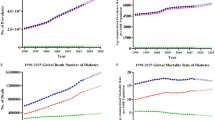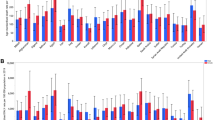Abstract
Objective:
To estimate the burden of disease attributable to overweight and obesity using disability-adjusted life-year (DALY) in Korea.
Research methods:
Firstly, overweight and obesity-related diseases and their relative risk (RR) were selected by the systematic review. Secondly, population-attributable fractions (PAFs) were computed by using the formula including RR and the prevalence of exposure (Pe) of overweight and obesity. Thirdly, DALYs of overweight and obesity-related diseases in Korea were estimated. Finally, the attributable burden (AB) of diseases due to overweight and obesity was calculated as the sum of the products from multiplying DALYs of overweight and obesity-related diseases by their PAFs.
Results:
The disease burden attributable to overweight was 827.1 person years (PYs) overall, 732.6 for men, 922.9 for women per 100 000 persons. The disease burden attributable to obesity was 260.0 PYs overall, 144.2 for men, 377.3 for women. Diabetes attributable to overweight and obesity accounts for highest burden among other diseases in both genders. The disease burden attributable to overweight was 3.2 times higher than that attributable to obesity.
Conclusion:
Most proportion of disease burden attributable to high body mass index (BMI) occurred among those with only moderately raised levels such as overweight, not the extremes such as obesity. It suggests that population-based, public health intervention rather than high-risk group-focused strategies are more effective to reduce the burden of disease attributable to overweight and obesity in Korea.
This is a preview of subscription content, access via your institution
Access options
Subscribe to this journal
Receive 12 print issues and online access
$259.00 per year
only $21.58 per issue
Buy this article
- Purchase on Springer Link
- Instant access to full article PDF
Prices may be subject to local taxes which are calculated during checkout
Similar content being viewed by others
References
British Nutrition Foundation Task Force. Obesity. Blackwell: Oxford, UK, 1999.
National Task Force on the Prevention and Treatment of Obesity. Overweight, obesity and health risk. Arch Int Med 2000; 160: 898–904.
Baek GJ, Ok RM, Nam SK, Jae HK, Tae HY, Sang YL et al. Socioeconomic costs of obesity for Korean adults. Kor J Prev Med 2002; 35: 1–12 (Korean).
WHO. Obesity-Preventing and managing the global epidemic. World Health Organization: Geneva, 1997.
Ministry of Health and Welfare. National Health and Nutrition Survey 1998 Korea. 1999.
Ministry of Health and Welfare. National Health and Nutrition Survey 2001 Korea. 2002.
Murray CJL, Lopez AD . The Global Burden of Disease: A Comprehensive Assessment of Mortality and Disability from Disease. Injuries and Risk Factors in 1990 and Projected to 2020. Harvard School of Public Health, WHO and World Bank: Boston, 1996.
Murray CJ, Salomon JA, Mathers CD, Lopez AD . Summary Measures of Population Health: Concepts, Ethics, Measurement and Applications. WHO: Geneva, 2002.
Rodgers A, Ezzati M, Vander Hoorn S, Lopez AD, Lin RB, Murray CJ . Distribution of Major Health Risks: Findings from the Global Burden of Disease Study. PLoS Med 2004; 1: e27.
National Institutes of Health. Clinical guidelines on the identification, evaluation and treatment of overweight and obesity in adults-the evidence report. Obes Res 1998; 6: 51S–209S.
Bray GA . Risks of obesity. Prim Care 2003; 30: 281–299.
Bray GA . Risks of obesity. Endocrinol Metab Clin North Am 2003; 32: 787–804.
Reilly JJ, Methven E, McDowell ZC, Hacking B, Alexander D, Stewart L et al. Health consequences of obesity. Arch Dis Child 2003; 88: 748–752.
Visscher TL, Seidell JC . The public health impact of obesity. Annu Rev Public Health 2001; 22: 355–375.
National Institute of Health. Clinical Guidelines on the Identification, Evaluation, and Treatment of Overweight and Obesity in Adults. Available at http://www.nhlbi.nih.gov/guidelines/obesity/ob_home.htm.
Overweight, obesity, and health risk. National Task Force on the Prevention and Treatment of Obesity. Arch Intern Med 2000; 160: 898–904.
CEBM(Center for Evidence Based Medicine). Levels of Evidence and Grades of Recommendation. available http://www.cebm.net/levels_of_evidence.asp (2003.11).
American Institute for Cancer Research. Food, nutrition and the prevention of cancer: a global perspective. American Institute for Cancer Research: Washington DC, 1997.
Norgan NG . Population differences in body composition in relation to the body mass index. Eur J Clin Nutr 1994; 48 (Suppl 3): 10–25; discussion 26–27.
Deurenberg-Yap M, Schmidt G, van Staveren WA, Deurenberg P . The paradox of low body mass index and high body fat percentage among Chinese, Malays and Indians in Singapore. Int J Obes Relat Metab Disord 2000; 24: 1011–1017.
Dudeja V, Misra A, Pandey RM, Devina G, Kumar G, Vikram NK . BMI does not accurately predict overweight in Asian Indians in northern India. Br J Nutr 2001; 86: 105–112.
Deurenberg-Yap M, Chew SK, Deurenberg P . Elevated body fat percentage and cardiovascular risks at low body mass index levels among Singaporean Chinese, Malays and Indians. Obes Rev 2002; 3: 209–215.
Deurenberg P, Deurenberg-Yap M, Foo LF, Schmidt G, Wang J . Differences in body composition between Singapore Chinese, Beijing Chinese and Dutch children. Eur J Clin Nutr 2003; 57: 405–409.
Deurenberg-Yap M, Chew SK, Lin VF, Tan BY, van Staveren WA, Deurenberg P . Relationships between indices of obesity and its co-morbidities in multi-ethnic Singapore. Int J Obes Relat Metab Disord 2001; 25: 1554–1562.
Tai ES, Ho SC, Fok AC, Tan CE . Measurement of obesity by anthropometry and bioelectric impedance analysis: correlation with fasting lipids and insulin resistance in an Asian population. Ann Acad Med Singapore 1999; 28: 445–450.
Jee SH, Pastor-Barriuso R, Appel LJ, Suh I, Miller III ER, Guallar E . Body mass index and incident ischemic heart disease in South Korean men and women. Am J Epidemiol 2005; 162: 42–48.
Zhou BF . Effect of body mass index on all-cause mortality and incidence of cardiovascular diseases – report for meta-analysis of prospective studies open optimal cut-off points of body mass index in Chinese adults. Biomed Environ Sci 2002; 15: 245–252.
Oh SW, Shin SA, Yun YH, Yoo T, Huh BY . Cut-off point of BMI and obesity-related comorbidities and mortality in middle-aged Koreans. Obes Res 2004; 12: 2031–2040.
He J, Ogden LG, Bazzano LA, Vupputuri S, Loria C, Whelton PK . Risk factors for congestive heart failure in US men and women: NHANES I epidemiologic follow-up study. Arch Intern Med 2001; 161: 996–1002.
Felson DT, Zhang Y, Hannan MT, Naimark A, Weissman B, Aliabadi P et al. Risk factors for incident radiographic knee osteoarthritis in the elderly: the Framingham Study. Arthritis Rheum 1997; 40: 728–733.
Furberg AS, Thune I . Metabolic abnormalities (hypertension, hyperglycemia and overweight), lifestyle (high energy intake and physical inactivity) and endometrial cancer risk in a Norwegian cohort. Int J Cancer 2003; 104: 669–676.
Van den Brandt PA, Spiegelman D, Yaun SS, Adami HO, Beeson L, Folsom AR et al. Pooled analysis of prospective cohort studies on height, weight, and breast cancer risk. Am J Epidemiol 2000; 152: 514–527.
Marshall FF . Obesity and renal cell carcinoma: a quantitative review. J Urol 2002; 168: 877.
O'Brien TE, Ray JG, Chan WS . Maternal body mass index and the risk of preeclampsia: a systematic overview. Epidemiology 2003; 14: 368–374.
Cedergren MI . Maternal morbid obesity and the risk of adverse pregnancy outcome. Obstet Gynecol 2004; 103: 219–224.
Kato I, Nomura A, Stemmermann GN, Chyou PH . Prospective study of clinical gallbladder disease and its association with obesity, physical activity, and other factors. Dig Dis Sc 1992; 37: 784–790.
Layde PM, Vessey MP, Yeates D . Risk factors for gall-bladder disease: a cohort study of young women attending family planning clinics. J Epidemiol Community Health 1982; 36: 274–278.
Weintraub JM, Willett WC, Rosner B, Colditz GA, Seddon JM, Hankinson SE . A prospective study of the relationship between body mass index and cataract extraction among US women and men. Int J Obes Relat Metab Disord 2002; 26: 1588–1595.
Kashyap S, Moher D, Fung MF, Rosenwaks Z . Assisted reproductive technology and the incidence of ovarian cancer: a meta-analysis. Obstet Gynecol 2004; 103: 785–794.
Walter SD . The estimation and interpretation of attributable risk in health research. Biometrics 1976; 32: 829–849.
Jung-Kyu L, Seok-Jun Y, Young KD, Young HK, Chang-Yup K, Kidong P et al. Disability Weights for Diseases in Korea. Kor J Prev Med 2003; 36: 1–26 (Korean).
Strauss RS . Childhood obesity and self-esteem. Pediatrics 2000; 105: e15.
Victorian Burden of Disease Study: Morbidity. Melbourne, Victoria: Victorian Government, Department of Human Services, Public Health and Development Division; 1999.
World Health Organization. The world health report 2002: Reducing risks, promoting healthy life. World Health Organization: Geneva, 2002; 250 pp.
Colditz GA, Willett WC, Stampfer MJ, Manson JE, Hennekens CH, Arky RA et al. Weight as a risk factor for clinical diabetes in women. Am J Epidemiol 1990; 132: 501–513.
Colditz GA, Willett WC, Rotnitzky A, Manson JE . Weight gain as a risk factor for clinical diabetes mellitus in women. Ann Intern Med 1995; 122: 481–486.
Carey VJ, Walters EE, Colditz GA, Solomon CG, Willett WC, Rosner BA et al. Body fat distribution and risk of non-insulin dependent diabetes mellitus in women. The Nurses' Health Study Am J Epidemiol 1997; 145: 614–619.
Njolstad I, Arnesen E, Lund-Larsen PG . Sex differences in risk factors for clinical diabetes mellitus in a general population: a 12-year follow-up of the Finnmark Study. Am J Epidemiol 1998; 147: 49–58.
Rose G . The strategy of preventive medicine. Oxford University Press: Oxford, 1992; 138 pp.
Rodgers A, Lawes C, MacMahon S . The global burden of cardiovascular disease conferred by raised blood pressure. Benefits of reversal of blood pressure-related cardiovascular risk in Eastern Asia. J Hypertens 2000; 18: S3–5.
Cook NR, Cohen J, Hebert P, Taylor JO, Hennekens CH . Implications of small reductions in diastolic blood pressure for primary prevention. Arch Intern Med 1995; 155: 701–709.
Murray CJL, Lauer JA, Hutubessy RCW, Niessen L, Tomijima N, Rodgers A et al. Effectiveness and costs of interventions to reduce systolic blood pressure and cholesterol: A global and regional analysis on reduction of cardiovascular disease risk. Lancet 2003; 361: 717–725.
Nam SK, Ok RM, Jae HK, Sang YL, Baek GJ, Sin JL et al. Increasing Prevalence of Obesity Related Disease for Koreans Associated with Overweight and Obesity. Kor J Prev Med 2001; 34: 309–315 (Korean).
Acknowledgements
This research was supported by a grant of the Korea Health 21 R&D Project, Ministry of Health & Welfare, Republic of Korea (01-PJ1-PG1-OICH10-0007).
Author information
Authors and Affiliations
Corresponding author
Rights and permissions
About this article
Cite this article
Park, JH., Yoon, SJ., Lee, H. et al. Burden of disease attributable to obesity and overweight in Korea. Int J Obes 30, 1661–1669 (2006). https://doi.org/10.1038/sj.ijo.0803321
Received:
Revised:
Accepted:
Published:
Issue Date:
DOI: https://doi.org/10.1038/sj.ijo.0803321
Keywords
This article is cited by
-
Impact of underweight on 3-year all-cause mortality in patients with acute severe hypertension: a retrospective cohort study
Scientific Reports (2022)
-
High-fat diet-induced obesity affects alpha 7 nicotine acetylcholine receptor expressions in mouse lung myeloid cells
Scientific Reports (2020)
-
Diet-induced obesity alters myeloid cell populations in naïve and injured lung
Respiratory Research (2016)
-
The Epidemiology of Obesity and Gastrointestinal and Other Diseases: An Overview
Digestive Diseases and Sciences (2008)
-
Work, Weight, and Wellness: The 3W Program: A Worksite Obesity Prevention and Intervention Trial
Obesity (2007)



